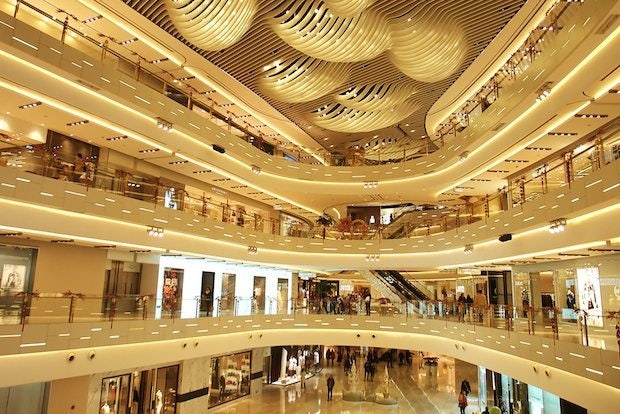
The iapm luxury mall in Shanghai. China's domestic luxury sales have taken a hit as more tourists head abroad to shop for tariff-free items. (Shutterstock)
In 2013, Chinese consumers spent approximately 600 billion yuan (roughly US$96 billion) on goods overseas through Haitao.com, shopping agents, and shopping tourism. It is widely believed that the main reason for China’s outflow of domestic demand lies in the domestic-foreign price difference, and that sky-high tariffs are the culprit of steep luxury-goods prices. Recently, Chinese media decided to ask, “Why are China’s tariffs so high—or are they really?”
A Chinese article on People’s Daily last week claimed to take a look at the myth and reality of China’s import tariffs, and argued that apart from value-added tax and sales tax, the tariffs levied on imported luxury goods might not be as high as we had thought:
A renowned French-branded cosmetic product with an 800-yuan per bottle retail price is in fact only levied a 2.3-yuan tariff. A bottle of an imported brand-name perfume with a retail price of 700 yuan is actually levied a 6.2 yuan tariff, which makes up less than 1 percent of the price. Namely, the retail price of goods at such price levels would perhaps only drop 3 to 5 yuan even if the tariff were brought down to 0 percent.
...
In China, the tariff rate applied on cosmetic products is typically 10 percent. It is, however, based on the declared import value rather than the retail price. The import value of luxury goods is generally as low as 3 to 20 percent of the domestic retail price, so even when value-added tax and sales tax are brought into the picture, they play a limited role in affecting the retail price.
While China’s cited tariff rates on specific luxury products may not be not particularly high, the article omitted tariffs on other types of goods such as automobiles, which can be as extreme as 21.5 percent. The article claims, however, that luxury brands are overcharging in China:
Since China’s entry into the World Trade Organization in 2010, it has realized its promises and the average tariff rate has come down to 9.8 percent, which is one-fourth of the world’s average. For major consumer goods such as clothing, handbags, and cosmetics, China’s tariff rate is apparently lower than other developing countries such as Brazil and India, and is fairly close to economically successful countries like [South] Korea. If we take a look at handbags, we can see India imposes a 35 percent tariff and a 24 percent sales tax on them, whereas we [China] levy a 10 percent tariff and no sales tax on this category. India’s retail prices for luxury goods are relatively low; take Coach handbags as an example: on average, their prices are approximately one-third of the mainland prices, and half of the prices in the United States.
The author argues that instead of trade policies, properties such as scarcity and uniqueness are what define luxury goods and raise their prices. Retail prices are determined by marketing strategies, brand value, dealers’ profits, advertising, logistics, and more:
When luxury products are mostly foreign imported, we [China] have limited control over the pricing through managing tariffs to narrow the domestic-foreign price gap. A case in point is that in 2012, we lowered tariffs on some cosmetic products, but instead of slashed prices, their cost soared.
The article is similar to the Chinese government's previous accusations that foreign automakers were hiking up prices of imports beyond the tariff percentage—which prompted electric automaker Tesla to speak out and announce that it would not artificially inflate its China price beyond the taxes, tariffs, and shipping costs associated with the vehicles.